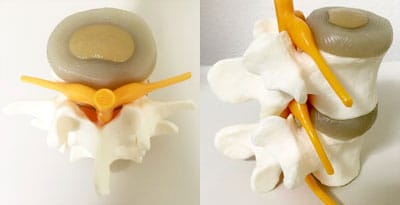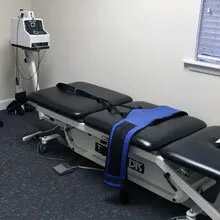Limited Appointments Available
What is Spinal Decompression Therapy?
Spinal Decompression Therapy is an effective non-surgical, non-invasive treatment used at Health 1st Wellness & Physical Medicine for complex spinal conditions. Some conditions we treat using this therapy are Spinal Stenosis, Bulging or Herniated Discs, and Degenerative Disc Disease.
Spinal Decompression uses a computerized system that targets compressed areas of the spine. It reduces pressure on the spine, with alternating cycles, by creating negative disc pressure. Looking to avoid back surgery and the associated risks that go along with surgery? Spinal Decompression Therapy may be the alternative you've been searching for!
Who is a Candidate for Spinal Decompression Therapy?
Research has shown that debilitating back or neck pain caused by bulging, herniated or ruptured, degenerative discs, as well as spinal stenosis, facet syndrome, and in some cases, failed back surgery, can often receive outstanding benefits from Spinal Decompression Therapy within only a few weeks. This gentle non-surgical approach has been proven to be safe and without side effects or complications once a patient has been determined to be a candidate for treatment.
Patients with complicated conditions such as high grade spondylolisthesis, severe osteoporosis, fractures, congenital par defects, or tumors are typically not candidates for Spinal Decompression Therapy. Patients with hardware from previous surgery (cage devices, screws, pins, rods, etc.) are also not candidates for treatment.

Phases Of Spinal Degeneration
However, we do offer other non-invasive modalities, such as Cold Laser Therapy, that may provide such patients considerable pain relief. Some patients with previous back surgery may be able to undergo spinal decompression therapy depending on the circumstances. Imaging such as X-rays, MRIs, and/or CT Scans help us in determining patient eligibility for this treatment.
What Does Spinal Decompression Therapy Do?
Patients often ask what causes a disc to degenerate and herniate. It's a great question that deserves a great answer. Once a person understands how the disc gets in bad shape, then how it's fixed will make perfect sense, and choosing surgery before a conservative non-surgical corrective approach will make no sense at all.
The ongoing breakdown of the human intervertebral disc occurs primarliy from the effects of compression over a period of years. The only time we aren't compressing our spine is when we are lying down, which for most people is approximately 8 hours out of a 24 hour day. Essentially, we spend two-thirds of our lives compressing the spine either sitting or standing. So if people live to be 90 years old, they will essentially be compressing their spines for 60 years.

We Customize Spinal Decompression Therapy To Meet Each Individual Patient's Level Of Comfort
Combining the compressional effects of gravity with bending, lifting, and twisting contributes to the process of disc degeneration and herniation. Spinal Decompression Therapy does the opposite of the compression that caused it in the first place.
The "Pump Mechanism" of Disc Nutrition Keeps the Disc Healthy...Without It, the Disc Degenerates and Herniates.
Anatomical studies have shown that healthy spinal discs are "avascular." This means that the discs have no blood supply to provide it nutrients. How does living disc material get water, oxygen, and nutrients? The discs are able to pump these vital components in and out of the discs by what is known as "the pump mechanism" of disc nutrition. The nutrients are released from the bone marrow in the vertebral body (round pillar part of the vertebra).
Normally, healthy spinal discs will get their nutrition when we are moving and carrying out our daily activities. As the discs are subjected to wear-and-tear, along with daily compression, they sometimes stop functioning efficiently. Loss of function begins to disable the "pump mechanism."

3-D Model Demonstrating Healthy Discs On A Normal Spine. Top-Down and Side Views.
The less the pump mechanism works, the faster the disc degenerates. It begins a vicious cycle that continues to break down and weaken the discs. The more the discs degenerate, the less motion they have, and the less motion they have, the more they degenerate.
A progressively degenerating disc loses the ability to "pump" nutrients in and out of the discs. Spinal Decompression Therapy restores the pump mechanism. Once the "pump mechanism" is restored, several very profound changes occur with the disc. First, the disc starts to re-hydrate. Second, the bulge or herniation begins to retract (pull back to its normal position). Lastly, the Annulus Fibrosus begins to heal.
Spinal Decompression Therapy utilizes a highly specialized machine that recreates the disc's pump mechanism of nutrition, and induces a negative pressure in the disc. As the machine pumps the disc, oxygen, water, and nutrients start flowing back into it, and the healing process begins.

3-D Model Demonstrating A Side View Of Degenerated Discs.
The device can specifically focus the pumping force on the vertebra above and below the disc, causing it to be "decompressed." A degenerated, bulging disc can't repair with just one pump. The computer on the machine utilizes a special algorithm that regulates the decompression in alternating progressive cycles.
This is all done without drugs, shots, or surgery! In fact, the treatment is so relaxing, many patients fall asleep while the machine is working.
Spinal Decompression Vs. Traction and Inversion Tables...Is There A Difference?
A question we frequently hear is, "won't inversion tables or traction do the same thing as Spinal Decompression Therapy?" The answer is: NO, there's a big difference. Traction has been around for hundreds of years, but it is critical to understand how decompression is distinguished from the others.
The reason traction fails in many cases compared to Spinal Decompression Therapy is because of how the body reacts to it. The skeletal muscles have "stretch receptors" that prevent them from being "over-stretched." When traction, whether standard or inversion traction, is performed, the spinal muscle stretch receptors try to protect the spine. They do this by stimulating a contraction reaction.
The whole reason for performing Spinal Decompression Therapy is to create a negative disc pressure. Traction does the opposite of spinal decompression as a result of the stretch receptors reacting. In essence, traction increases disc pressure, the opposite of the desired effect. For this reason, patients with herniated discs will often feel more pain after receiving traction than they did before the treatment.

Non-Surgical Spinal Decompression Therapy
Another difference in traction and spinal decompression is that a computer provides progressive and regressive rhythmic alternating steps to re-create the "pump mechanism" we discussed earlier. Decompression therapy also has the ability to isolate the specific segment that needs the treatment. Traction can't do this. Spinal Decompression Therapy is a gentle therapeutic approach -- there are no painful exercises or shots, and it feels great to the patient!
I am Interested in Spinal Decompression Therapy. What Should I Do Now?
Now that you know how Spinal Decompression Therapy works, and the benefits is has to offer, you may be wondering what the next steps are. To find out if you are a candidate for this treatment, call our office and schedule an appointment. We offer an introductory FREE Consultation for new patients.
During the consultation, you will be able to discuss your condition with the doctor. If it is determined that you may be a candidate after the consultation, you will be examined to determine the nature and extent of your condition. Recommendations will be provided based on these findings. Call our office at 501-881-4407 to Schedule an Appointment Today!
